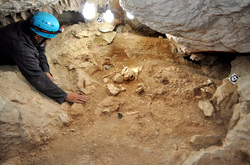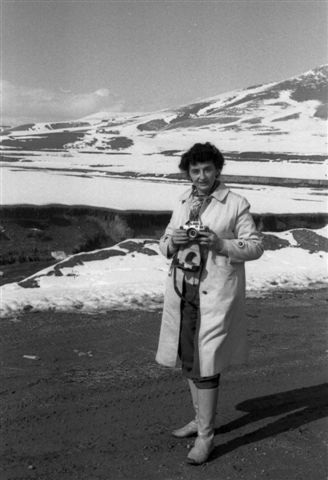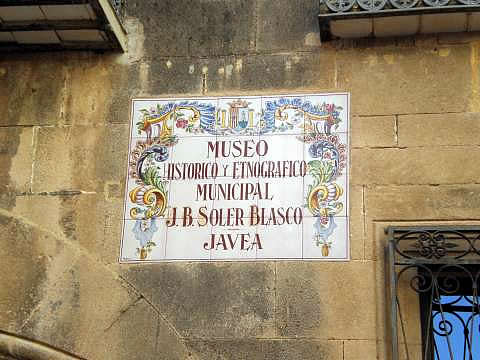 Amjasa and the Town hall collaborate in this great archaeological project initiated by the Cirne Cultural Foundation The new phase completed the sifting of the strata of sediment which contained ten human burials from the neolithic period. which carbon14 dating put between 2670 and 2250 BC. The remains were accompanied by grave goods, including tools such as arrowheads, stone axes, ceramic vessels, jewelry made with sea-shells and bones fashioned into needles. The archaeologist who led the excavation, Juan de Dios Boronat, highlighted the finding of a punch.made of copper This material was very unusual for the period and was undoubtedly imported from somewhere distant from Xàbia. It contextualises the changing times. Another important result was obtained in a survey of another, deeper layer of the cave, about 20 cm below the burials previously studied. Boronat revealed this was the discovery of more, earlier, skeletal remains, which reveal the presence of other burials made between 200 and 300 years before those previously analysed. All the results of the excavations are being recorded with the innovative technique of photogrammetry, which has enabled the making of a documentary in 3D giving an idea of this inaccessible cavity in the Montgó.. This will be presented at a competition for scientific documentaries in Baracaldo. The importance of the archaeological site in the Migdia, which combine burials with rock paintings more than 5000 years old, began to be diivulged a few months ago through a comprehensive exhibition. This was was first displayed in the head office of the Cirne Cultural Foundation (which initiated and has coordinated this ambitious archaeological study), the Soler Blasco Museum in Xàbia and the MARQ in Alicante. It will now go to Guardamar del Segura and possibly then travel to Barcelona. Xàbia Town Hall and Amjasa, the Municipal water company, are contributing financially to the project. As explained by Mayor, José Chulvi: ...for Xàbia " ...it is a luxury and great fortune to have a foundation like Cirne" and argued that public institutions "could not but collaborate with what is very important work, with great scientific and social impact ". Therefore within the context of their responsibility to social and cultural activities, Amjasa signed a collaborative agreement which provides 16,000 euros to the Foundation, which in return will prepare an exhibition on local history related to water to be shown to schools next year. The Town Hall also included a first agreement to aid Cirne in the current budget. Its chairman, Enric Martinez gave thanks for the municipal involvement and announced projects upon which they are working such as the water exhibition and another which will provide a perspective on Xàbia in the 1940's and 1950's. Further collaboration with the cultural foundation is being channelled through the Museum and its archaeologist, Ximo Bolufer, who is involved in the Migdia excavations and the study of materials found. In addition, AMUX, the Friends of the Museum Association has offered assistance to the project through translation of the documentary about the cave into English. Translated from Press Release
1 Comment
Sylvia Matheson (Schofield) (1916-2006) was an archaeologist and BBC journalist who made her final home in Jávea. She donated a collection of Afghan ceramics to the Soler Blasco Museum.
This article describes her perspective on the state of archeaology in Jávea in 1996 Walking on History Here is some information about Sylvia in Encyclopaedia Iranica Written in Valenciano by Isabel Català Arbona ( 10 years old) Primary 6, Graüll College, Xàbia . Isabel has written a concise and easy to understand account - complete with pictures Congratulations Isabel !
See our Blog in Valenciano |
ACTIVITIES
Categories |
- Home
- Blogs
-
Projectes
- Premio de Investigación - Formularios de Inscripción
-
Traducciones Translations
>
-
DISPLAY PANELS - GROUND FLOOR
>
- THE STONE AGES - PALAEOLITHIC, EPIPALAEOLITHIC AND NEOLITHIC
- CAVE PAINTINGS (ARTE RUPESTRE)
- CHALCOLITHIC (Copper) & BRONZE AGES
- THE IBERIAN CULTURE (THE IRON AGE)
- THE IBERIAN TREASURE OF XÀBIA
- THE ROMAN SETTLEMENTS OF XÀBIA
- THE ROMAN SITE AT PUNTA DE L'ARENAL
- THE MUNTANYAR NECROPOLIS
- ARCHITECTURAL DECORATIONS OF THE PUNTA DE L'ARENAL
- THE ATZÚBIA SITE
- THE MINYANA SMITHY
- Translations archive
- Quaderns: Versión castellana >
- Quaderns: English versions >
-
DISPLAY PANELS - GROUND FLOOR
>
- Catálogo de castillos regionales >
- Exposició - Castells Andalusins >
- Exposición - Castillos Andalusíes >
- Exhibition - Islamic castles >
- Sylvia A. Schofield - Libros donados
- Mejorar la entrada/improve the entrance >
-
Historia y enlaces
-
Historía de Xàbia
>
- Els papers de l'arxiu, Xàbia / los papeles del archivo
- La Cova del Barranc del Migdia
- El Vell Cementeri de Xàbia
- El Torpedinament del Vapor Germanine
- El Saladar i les Salines
- La Telegrafía y la Casa de Cable
- Pescadores de Xàbia
- La Caseta de Biot
- Castell de la Granadella
- La Guerra Civil / the Spanish civil war >
- History of Xàbia (English articles) >
- Charlas y excursiones / talks and excursions >
- Investigacions del museu - Museum investigations
- Enllaços
- Enlaces
- Links
-
Historía de Xàbia
>
- Social media
- Visitas virtuales
- Tenda Tienda Shop



 RSS Feed
RSS Feed
